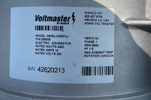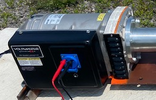Thanks for clarifying. As a person with limite knowledge in the field, I appriciate the patience.
I have done a lot of research on wind turbines. They do control blade pitch to manage speed, but they generator do turn at varying rpms. It might not be noticeable by the blade speed, but the gearbox ratio makes slight differences in blade bigger differences at the motor. That is why most make AC to DC back to AC.
So my generator is an alternator without the internal control of the the rotor field. I am curious to learn more about that and how it is implemented in AC machines (like the one I have) to make them be an "alternator"
I have done a lot of research on wind turbines. They do control blade pitch to manage speed, but they generator do turn at varying rpms. It might not be noticeable by the blade speed, but the gearbox ratio makes slight differences in blade bigger differences at the motor. That is why most make AC to DC back to AC.
So my generator is an alternator without the internal control of the the rotor field. I am curious to learn more about that and how it is implemented in AC machines (like the one I have) to make them be an "alternator"


